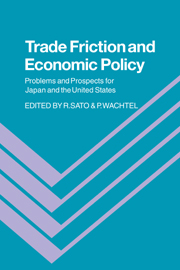Book contents
- Frontmatter
- Contents
- Foreword by Richard R. West
- Preface
- List of contributors
- 1 Introduction
- Part I Sources of trade friction
- Part II Macroeconomic policy
- 6 The U.S. and Japanese economies in the remaining Reagan years
- 7 U.S. macroeconomic policy and trade relations with Japan
- 8 New financial aspects of the U.S.–Japanese trade relationship
- 9 Japanese–U.S. current accounts and exchange rates before and after the G5 agreement
- Part III Trade policy
- Index
7 - U.S. macroeconomic policy and trade relations with Japan
Published online by Cambridge University Press: 05 February 2012
- Frontmatter
- Contents
- Foreword by Richard R. West
- Preface
- List of contributors
- 1 Introduction
- Part I Sources of trade friction
- Part II Macroeconomic policy
- 6 The U.S. and Japanese economies in the remaining Reagan years
- 7 U.S. macroeconomic policy and trade relations with Japan
- 8 New financial aspects of the U.S.–Japanese trade relationship
- 9 Japanese–U.S. current accounts and exchange rates before and after the G5 agreement
- Part III Trade policy
- Index
Summary
I am pleased to have this opportunity to discuss a subject that is close to all of the conference participants. This report comes at the end of a day and a half of talk about tensions between the United States and Japan concerning economic matters, and I suppose my message, if it could be summed up in a few words, is “not to worry.” I have not participated in recent official discussions of economic relations between United States and Japan, but I did participate, on earlier occasions, in discussions of issues of great tension. One was the first Nixon shock, when we closed the gold window, and allowed the dollar to drop. This disconcerted the Japanese to some considerable degree. A second was the shock in 1973 when the Nixon administration embargoed the export of soybeans.
There are several lessons from those events and, perhaps, from what is going on now. One is that the tension, insofar as it is not focused in particular sectors that are affected but is felt by the country at large, is largely a result of misunderstanding. This seems to be true here in the United States and is also, supposedly, true in Japan. Partly, the misunderstanding is about motivation; there is a feeling that one or the other country is guilty of a hostile act toward the other. At least in the case of the United States, we were mainly guilty of neglect when we went to Camp David in 1971 and closed the gold window.
- Type
- Chapter
- Information
- Trade Friction and Economic PolicyProblems and Prospects for Japan and the United States, pp. 100 - 109Publisher: Cambridge University PressPrint publication year: 1987



